There is no agreement among Iranian officials about how many people live below the poverty line in the Islamic Republic. Not only does this mean it's impossible to get a clear picture of poverty, it also makes it difficult to combat the problem itself.
On August 31, Mohammad Nahavandian, President Rouhani’s Vice President in Economic Affairs, stated that 10 million Iranians live below the poverty line. But less than three weeks later, on September 17, Parviz Fattah, head of the big state-supported charity organization the Imam Khomeini Relief Foundation, said that up to 20 million people could actually be living below the poverty line [Persian links]. According to Fattah, defining what “absolute poverty” means has political implications, as well as consequences in terms of how Iran engages on the international stage — implying that these were the reasons why Iranian authorities could not agree on a clear and reliable number.
And yet, by analyzing official statistics, it is possible to estimate the number of people who live below the poverty line. And the figures show that the number is much higher than those cited by Iranian officials themselves. What is more important, however, is that the data also shows that the number of households living below the poverty line has been increasing in recent years.
Statistical Transparency: A Government Threat?
If the government published clear and official data about relative and absolute poverty lines, it could use such analysis to determine policy. Such data would also make it possible to hold governments to account and, at the same time, prevent confusion and baseless speculations. But in Iran, the government views such statistical transparency as a threat and so refuses to publish official statistics on the issue.
Iran’s Statistics Center published the most recent official statistics about the poverty line in Iran in 2014. In that year, the absolute poverty line for an urban household in Iran was defined as being around one million tomans, or close to $300.
Poverty is defined variably, but a simple definition would include scarcity or lack of a certain amount of material possessions or money. In pure economic terms, according to UNESCO, the UN’s educational, science and culture organization, income poverty is when a family's income fails to meet a certain threshold. This threshold differs across countries, but typically it is measured with respect to families and not the individual, and is adjusted for the number of persons in a family.
Frequently, poverty is defined in either relative or absolute terms. Absolute poverty measures poverty in relation to the amount of money necessary to meet basic needs such as food, clothing, and shelter. Relative poverty defines poverty in relation to the economic status of other members of the society — i.e. people are poor if they fall below prevailing standards of living in a given societal context.
Poverty is usually measured by the level of consumption of households and their cost of living. By adopting this approach, it is possible to arrive at a more updated and accurate estimate of the poverty line in Iran by analyzing data from the Central Banks’ Urban Household Budget Project or the Statistical Center’s Household Expense-Income Project. The annual projects of the Statistics Center provide more comprehensive information because they provide separate data about urban and rural areas. However, the center has not published details since 2014. Because of this, our report uses data from the Central Banks’ Urban Household Budget Project, which provides information until the end of the Iranian calendar year 1395 (March 20, 2017).
There is a range of methods for measuring the poverty line, and depending on various research and geographical criteria, these methods will mean analysts will arrive at different results. One of the simplest methods, used by the Iranian Central Bank, is based on research done for the bank [Persian PDF] that uses a coefficient (66 percent of the median) of the expenses of an average family over a year to determine the relative poverty line.
Chart 1 illustrates changes to the relative poverty line in Iran from the Iranian calendar year 1385 to 1395 (March 21, 2006 to March 19, 2016). As the chart shows, if in 1385 an urban Iranian household with a monthly income of less than 400,000 tomans (a little over $180) was considered relatively poor, in 1395 a family with the monthly income of 2.2 million tomans (around $650) was considered relatively poor. This is a steep increase, but it is in line with the very high inflation rates that affected the economy in those years.
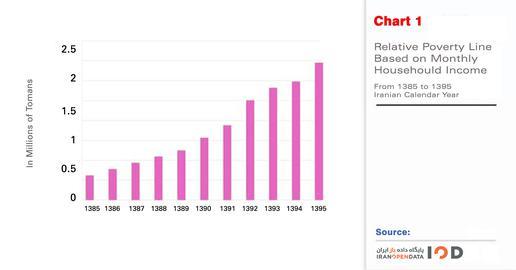
Where is the Poverty Line?
To better understand the concept of the poverty line, it is necessary to identify what percentage of Iranian households lived under the poverty line. Even though the statistics presented here are confined to urban households, considering that the urban population is 74 percent of a total population of almost 80 million, the statistics relating to the urban poor must be considered to be a deciding factor. Chart 2 is an estimate of the population living under the relative poverty line using the relative poverty line and looking at the distribution of households in terms of expenditure groups.
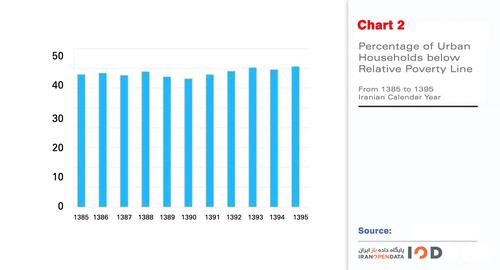
[Source: Iranian Central Bank’s Annual Report on Household Budgets in Urban Areas]
The graph shows that, in the last 10 years, the number of people living under the relative poverty line has constantly fluctuated between 40 to 45 percent of the population. In 1385 (2006), this percentage was close to 42, while in 1395 (2016) it was near 44.5 percent. It is also important to note two sub-trends here: The downturn in the poverty line in the two years of 1389 (beginning in spring 2010) and 1390, and its upturn since 1391 (2011) to the present.
The downturn trend can be attributed to the so-called Targeted Subsidy Project introduced in late 1388 (January 2010) under President Ahmadinejad, who claimed that the implementation of the project would eradicate unemployment and poverty in Iran within three years. It does appear to have slightly reduced poverty for two years, but suddenly, in 1391 (March 2012) the rate of increase resumed. This year coincided with both the enforcement of strict sanctions against Iran over its nuclear program and, partly, the subsidies themselves, which drove up inflation. After 1391 and 1392, the sanctions eased but the economy of Iran has been in such bad shape that the percentage of the population under the poverty line has been increasing.
The Government’s Anti-Poverty Budget
Periodic fluctuations aside, the findings above show that attempts by various Iranian administrations to fight poverty have not produced the desired results.
The executive branch in Iran is the official guardian of the economy and social welfare, but other foundations and institutions play a role here too. For example, the Mostazafan Foundation and the Executive Headquarters of Imam's Directive are also tasked with fighting poverty, but there is no reliable information available about the budgets or the expenditures of these institutions, which work directly under the supervision of the Supreme Leader. And the Iranian government does not itemize what it spends on fighting poverty either.
Considering these shortcomings, our report uses data from two official institutions responsible for fighting poverty, the Welfare Organization and the Imam Khomeini Relief Foundation, both of which are funded directly by the Iranian government. According to statistics released by the head of the Imam Khomeini Relief Foundation [Persian link], in 1395 (the year beginning in March 2016), five million people were assisted by this foundation. The number of people who were covered by the Welfare Organization in the same year was two million.
In 1387 (2008) the Welfare Organization received 434 billion tomans (over $128 million) from the government, while the Relief Foundation received 1,497 billion tomans (close to $442 million). In 1395 (2016) these numbers increased to 1,934 billion tomans (around $572 million) for the Welfare Organization and 4,029 billion tomans (close to 1.2 billion) for the Relief Foundation.
Chart 3 shows the changes in the budgets of these two organizations between 1387 and 1395 adjusted for inflation, based on 1387 fixed prices. The graph shows that between 1388 and 1392, the years when inflation was highest in Iran, the budgets for these two increased at a rate less than the rate of inflation. In other words, the foundations actually received less money, even though monetary amounts were higher. This paralleled the increase in poverty in the years after 1390.
During President Rouhani’s first term in office, this trend was reversed. From 1393 on, the two budgets increased more than the rate of the inflation. Nevertheless, the total budget for fighting poverty is much less than what it was in 1387 when it was adjusted for inflation.
On the other hand, in these years, the Iranian government paid 40 trillion tomans (more than $11.8 billion) cash subsidies to Iranian households. The amount of the cash subsidy to each individual per month has remained at 45.5 thousand tomans ($13.50) since 1389 but, if inflation is taken into account, at the end of 1395 (March 20, 2017) the buying power of the subsidy was one-fifth of what it had been in 1387. Taken together, the drop in the real value of the budget and the reduction in the value of cash subsidies explains why the number of households below the poverty line has increased in recent years.
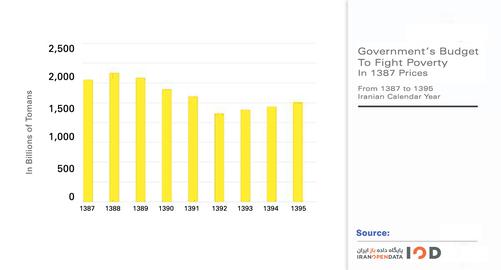
Conclusions
The statistical trends discussed above make a few facts very clear:
- First, the refusal of the Iranian government to officially determine the poverty line has led to the adoption of various methods and viewpoints in order to calculate where the line sits, leading to a lack of clear-cut analyses. What is more, confusion in statistics and reliance on speculation means that the government cannot be held accountable. It means that it cannot be forced to set effective policies.
- Second, after a relative decrease in poverty over a brief period, the number of households below the poverty line has begun to increase yet again.
- Lastly, statistics show that if something is not done quickly to fight poverty in Iran, the trend toward an increase in the number of households below the poverty line will continue, and poverty will become more widespread. As it is, almost half of Iranian urban households now live below poverty line.
Sources Available on Iran Open Data:
The executive budget summary for the year 1395
The executive budget summary for the year 1394
The executive budget summary for the year 1393
The executive budget summary for the year 1392
The executive budget summary for the year 1391
The executive budget summary for the year 1390
The executive budget summary for the year 1389
The executive budget summary for the year 1388
Expenditures of main devices in 1387
Average gross cost of urban households divided by different price bands from 1386 to 1395
visit the accountability section
In this section of Iran Wire, you can contact the officials and launch your campaign for various problems




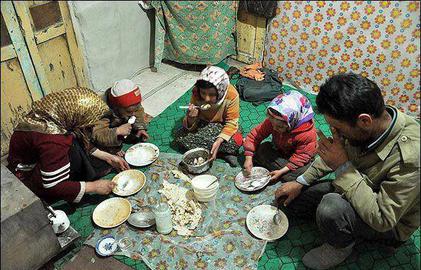



















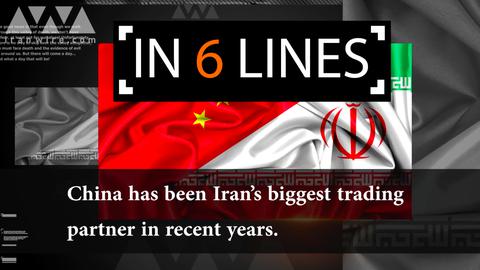
comments